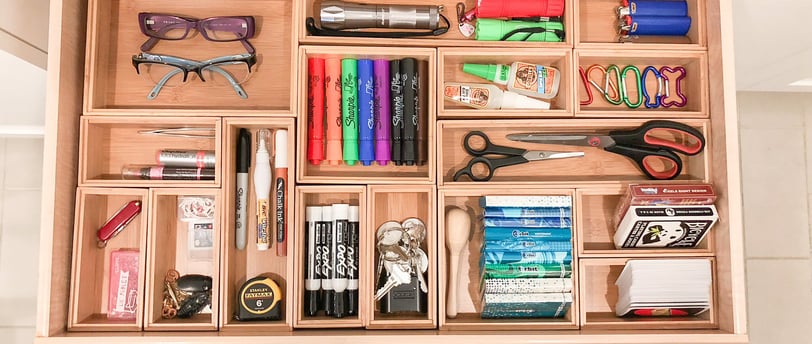ORGANIZING FROM A TO Z
JUNK DRAWER NO MORE
"Being organized is being in control."


Organizing your junk drawer may seem like a small task, but it can have a significant impact on your daily life. A cluttered junk drawer can cause frustration and inefficiency, making it harder to find items when you need them. By taking time to organize it, you'll have easier access to essentials and reduce unnecessary clutter throughout your home.
Importance of Organizing Your Junk Drawer:
Saves Time: When everything is in its place, you won’t waste time searching for items like pens, batteries, or tape.
Reduces Clutter: A cluttered junk drawer can spill over into other areas of your home. Organizing it helps control the overall mess in your space.
Improves Productivity: A clean, organized drawer allows you to quickly grab what you need, boosting productivity and reducing stress.
Reduces Waste: Sorting through your drawer lets you identify duplicates or expired items you no longer need, helping you avoid wasting items or buying things you already have.
Steps to Organize Your Junk Drawer:
Empty the Drawer Completely
Start by taking everything out of the drawer. Lay everything out on a flat surface where you can see all the items.
This step allows you to assess what you actually have and prevents you from missing anything hidden at the bottom.
Sort and Categorize the Items
Identify Categories: Divide items into categories based on their function or type. Common categories for a junk drawer include:
Office Supplies: Pens, paper clips, rubber bands, staplers, post-it notes, tape, scissors, highlighters, etc.
Tools: Screwdrivers, nails, batteries, tape measure, small wrenches, and pliers.
Miscellaneous: Flashlights, batteries, small cords, keys, spare change, or other random items.
Electrical: Extra chargers, adapters, batteries, or spare light bulbs.
Crafts/DIY Supplies: Glue, screws, small nails, fabric, etc.
Coupons/Receipts: If you tend to keep coupons or receipts in the drawer.
Purge Unnecessary Items: During the sorting process, remove anything that is broken, expired, or no longer useful. This helps eliminate the clutter.
Clean the Drawer
Before you start organizing, wipe down the drawer with a damp cloth to remove dust, crumbs, or sticky residues.
For deeper cleaning, you might want to remove any drawer liners or organize the contents more thoroughly.
Select Organizing Tools
Depending on the size of the drawer and the number of categories you have, choose organizing tools that will help you keep everything separated and easy to access.
Organize and Arrange the Items
Place Items Back: Use dividers, bins, or small containers to create sections for each category. Arrange items in the order that makes sense for how often you use them, with frequently used items in the front.
Use Storage Containers: Small clear containers or bins can hold loose items like batteries or screws, while larger ones are great for keeping tools or craft supplies organized.
Group Similar Items: Within each category, group similar items together to make it easy to find what you need. For example, keep all the pens in one section, tape in another, and batteries in a third.
Label Sections
If you use containers or dividers, labeling each section can make it easier to know where everything belongs. You can use adhesive labels or simple masking tape for a quick, effective label.
Regular Maintenance
Check your junk drawer regularly to keep it tidy. Every few months, re-assess what’s in the drawer, remove expired items, and reorganize as needed.
Supplies to Organize Your Junk Drawer:
Drawer Dividers: Adjustable dividers help separate different categories and maximize the use of space. Some dividers are made of plastic, bamboo, or even foam and are customizable for different drawer sizes.
Small Bins or Containers: Clear plastic bins or trays are great for grouping small items like batteries, screws, or paper clips. The transparency allows for easy identification of contents.
Trays: A simple tray can work well for pens, pencils, and small office supplies. Trays help corral items into a defined space.
Ziplock Bags: For loose or smaller items (like rubber bands or spare keys), small ziplock bags can be used to group items together and reduce clutter.
Command Hooks or Clips: If your junk drawer is deep enough, adding a few small hooks or clips inside the drawer can be useful for hanging small tools like scissors or tape rolls.
Small Storage Containers: Use these for storing batteries, spare screws, or spare change. Containers with lids can help keep things secure.
Label Maker or Labels: A label maker or simple adhesive labels help you quickly mark which section contains which items.
Drawer Liners: A drawer liner can prevent small items from sliding around and keep everything in place.
Expandable Organizers: For deeper drawers, expandable organizers that adjust to fit the space can help keep items grouped together while also maximizing space.
Categorizing Items for the Junk Drawer:
Stationery/Office Supplies: Pens, pencils, sticky notes, paper clips, rubber bands, scissors, tape, rulers.
Tools & Hardware: Screwdrivers, nails, wrenches, batteries, light bulbs, pliers, glue, measuring tape, multi-tools.
Miscellaneous: Extra keys, receipts, business cards, coupons, flashlights, calculators, spare change.
Electronics: Chargers, headphones, cords, adapters, spare phone cases, old gadgets.
Health & Safety: Band-aids, thermometer, medicines, hand sanitizer, disinfectant wipes.
Craft & DIY Supplies: Craft scissors, needles, thread, buttons, small fabrics, stamps, glue sticks.
